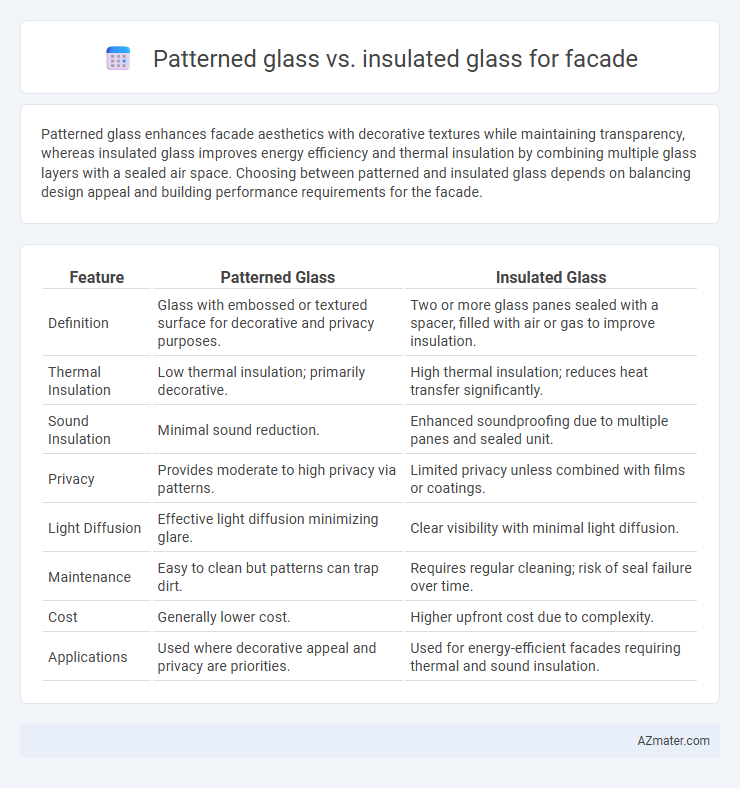Patterned glass enhances facade aesthetics with decorative textures while maintaining transparency, whereas insulated glass improves energy efficiency and thermal insulation by combining multiple glass layers with a sealed air space. Choosing between patterned and insulated glass depends on balancing design appeal and building performance requirements for the facade.
Table of Comparison
| Feature | Patterned Glass | Insulated Glass |
|---|---|---|
| Definition | Glass with embossed or textured surface for decorative and privacy purposes. | Two or more glass panes sealed with a spacer, filled with air or gas to improve insulation. |
| Thermal Insulation | Low thermal insulation; primarily decorative. | High thermal insulation; reduces heat transfer significantly. |
| Sound Insulation | Minimal sound reduction. | Enhanced soundproofing due to multiple panes and sealed unit. |
| Privacy | Provides moderate to high privacy via patterns. | Limited privacy unless combined with films or coatings. |
| Light Diffusion | Effective light diffusion minimizing glare. | Clear visibility with minimal light diffusion. |
| Maintenance | Easy to clean but patterns can trap dirt. | Requires regular cleaning; risk of seal failure over time. |
| Cost | Generally lower cost. | Higher upfront cost due to complexity. |
| Applications | Used where decorative appeal and privacy are priorities. | Used for energy-efficient facades requiring thermal and sound insulation. |
Introduction to Facade Glass Types
Patterned glass offers decorative textures and privacy while allowing natural light to diffuse, making it ideal for aesthetic facade applications. Insulated glass consists of two or more glass panes separated by an air or gas-filled space, providing superior thermal insulation and energy efficiency for building facades. Choosing between patterned glass and insulated glass depends on balancing design appeal with performance requirements like heat retention and noise reduction.
What is Patterned Glass?
Patterned glass is textured or embossed glass designed to enhance privacy and aesthetic appeal on building facades by diffusing light and obscuring visibility. Unlike insulated glass, which consists of two or more panes separated by a spacer to improve thermal performance, patterned glass primarily focuses on decorative and functional surface patterns rather than insulation. This makes patterned glass ideal for facades requiring privacy without compromising light transmission.
What is Insulated Glass?
Insulated glass, also known as double-glazed or triple-glazed glass, consists of two or more glass panes separated by an air or gas-filled space to reduce heat transfer and improve energy efficiency in building facades. It provides superior thermal insulation, soundproofing, and condensation resistance compared to single-pane options like patterned glass, making it ideal for modern facade designs targeting sustainability. The gas fill, usually argon or krypton, enhances the insulation properties, while low-emissivity (Low-E) coatings on the glass surfaces further optimize energy performance.
Aesthetic Differences: Patterned vs Insulated Glass
Patterned glass enhances facade aesthetics with intricate textures and designs, providing privacy and decorative appeal without sacrificing natural light. Insulated glass focuses on energy efficiency, featuring multiple panes separated by a spacer to reduce heat transfer while maintaining clarity and brightness. The choice between patterned and insulated glass balances visual complexity and thermal performance, influencing the overall facade style and functionality.
Thermal Performance: Energy Efficiency Comparison
Patterned glass offers moderate thermal performance by diffusing natural light and reducing glare but lacks substantial insulation, making it less energy-efficient compared to insulated glass. Insulated glass units (IGUs), featuring multiple panes separated by air or inert gas fills, provide superior thermal resistance with low U-values, significantly reducing heat transfer and improving facade energy efficiency. Comparing thermal metrics, insulated glass can lower heating and cooling demands by up to 30%, making it the preferred option for energy-efficient facade applications.
Light Transmission and Privacy Considerations
Patterned glass offers varied light transmission levels by incorporating textures that diffuse sunlight, enhancing privacy while allowing natural illumination. Insulated glass typically consists of multiple panes separated by air or gas, maximizing thermal efficiency and maintaining clear visibility with minimal obstruction to light flow. Choosing between patterned and insulated glass depends on balancing desired transparency and privacy needs for facade design.
Acoustic Insulation: Which Glass Performs Better?
Patterned glass offers limited acoustic insulation due to its textured surface, which primarily affects visual diffusion rather than soundproofing. Insulated glass, composed of two or more panes separated by an air or gas-filled spacer, significantly enhances acoustic performance by reducing sound transmission through its multi-layer structure. For facade applications where noise reduction is critical, insulated glass outperforms patterned glass by providing superior sound insulation and improving overall building comfort.
Durability and Maintenance Requirements
Patterned glass offers moderate durability with surface textures that can resist minor scratches and conceal dirt, but it often requires regular cleaning to maintain its aesthetic appeal. Insulated glass, designed with multiple panes and gas fills, provides superior durability by reducing thermal stress and enhancing resistance to impact and weather conditions, resulting in lower long-term maintenance needs. For facade applications, insulated glass is generally preferred due to its enhanced structural integrity and energy efficiency, which translates into reduced upkeep costs over time.
Cost Analysis: Patterned vs Insulated Glass
Patterned glass generally costs less upfront compared to insulated glass due to simpler manufacturing processes and fewer material layers. Insulated glass, which features multiple panes with gas-filled spaces, offers superior thermal performance that can reduce long-term energy costs despite higher initial expenses. Choosing between patterned and insulated glass involves weighing initial investment against potential savings in heating and cooling energy over the building's lifespan.
Choosing the Right Glass Type for Your Facade
Patterned glass offers unique decorative textures that enhance privacy and diffuse light, making it ideal for aesthetic facades and moderate insulation needs. Insulated glass, composed of two or more glass panes separated by a gas-filled space, maximizes thermal performance and energy efficiency, crucial for climates requiring strict temperature control. Selecting the right glass type depends on balancing design goals, insulation requirements, and budget constraints to optimize facade functionality and appearance.

Infographic: Patterned glass vs Insulated glass for Facade
 azmater.com
azmater.com